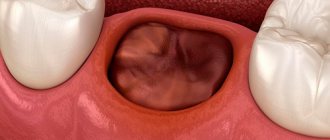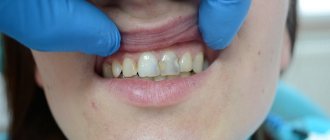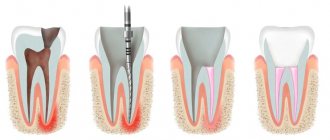27.11.2019
It happens that a person suddenly feels that his gums smell like rot. Many people immediately begin to worry and search the Internet for the most effective folk remedies. However, dentists warn that an unpleasant odor is evidence of infection of the oral cavity and the formation of pus. Without proper therapy, recovery is impossible. That is why you should not rely on home methods - it is better to contact a specialist for diagnosis and development of the most effective therapeutic course.
The main reasons why a tooth under a crown begins to smell bad
Wearing a prosthesis longer than expected . Over time, when wearing a denture for a long time, the gum tissue atrophies, and the area of the neck of the tooth is exposed. A loose connection of the crown to the gum causes the formation of a gap into which food debris gets trapped. It is impossible to remove accumulated substrate from under the crown using traditional methods: toothbrush, rinsing. As a result, an environment favorable for the growth of bacteria is formed under the crown, which in the course of their life emit foul-smelling sulfur dioxide gases.
Violation of the seal between the crown and the tooth . The reason is most often the incorrect installation of the prosthesis or the resorption of the material that was used to fix the artificial crown to the supporting tooth. Pathogenic microflora, penetrating into the formed cavities, causes secondary caries and inflammation of the gums.
If the crown is metal-ceramic, then under the influence of salivary secretions and oxygen in the air, the metal in its composition undergoes oxidation, which causes an unpleasant odor. In addition, the resulting oxides irritate the mucous membranes of the gums and can provoke allergic reactions.
Lack of tooth protection after grinding . One of the stages of preparation for prosthetics is preparation - removal of the enamel coating, which protects tooth tissue from mechanical damage and the action of microbes. If, before installing a permanent prosthesis, the ground tooth is not covered with a temporary crown or treated with cement, then bacteria settle on it and continue their destructive activity under the prosthesis.
Violation of the technological process of manufacturing and installing a prosthesis . If a crown is installed incorrectly, regardless of the reason (insufficient experience of dental technicians and orthopedists, use of low-quality materials), soft tissue injury occurs, followed by infection and the development of inflammation.
Poor oral hygiene . Artificial structures - dentures require special care and cleaning. If you neglect the rules of hygiene, pathogenic microorganisms begin to actively multiply, causing putrefactive processes.
Poor quality dental treatment . One of the main conditions for successful prosthetics is the absence of infection in the oral cavity. If teeth that are subject to prosthetics have a defect in filling the dental canals, a granuloma or cyst filled with pus may form at the apex of the root.
When teeth affected by caries appear under the crown, the decay process continues and ends with complete destruction and death of the tooth.
Symptoms of tooth decay under the crown
The first sign of an inflammatory process under a prosthesis is not pain, as many people think, but an unpleasant odor. This happens because at the stage of preparation for prosthetics, the tooth is usually depulped, that is, the neurovascular bundle, which is responsible for sensitivity, is removed.
- An unpleasant taste first appears in the mouth, then a putrid odor is added, which cannot be masked by any chewing gum or mouthwash.
- The patient discovers a gap between the crown and the gum, where food debris gets in, which becomes a breeding ground for microbes.
- Often, inflammation of the gums develops near the tooth with the formation of soft tissue swelling.
- If the tooth has not been pulped, then severe pain is present.
- Blackening of the tooth under the crown.
All these symptoms indicate an advanced putrefactive process in the tooth covered with a crown. You should immediately seek medical help from a dentist.
Ignoring the problem leads to dire consequences:
- formation of a purulent cyst at the apex of the root;
- complete tooth destruction;
- the formation of periostitis or gumboil;
- spread of purulent infection along with blood or lymph flow to other organs.
Recognize the problem in time
How to determine on your own whether there is an unpleasant odor from a tooth?
There are simple and accessible diagnostic methods for this:
- Ask people around you. Surely, if there was a fetid amber, they would definitely pay attention to it. If this has not happened yet, you can ask them if there is a similar problem.
- Ask your doctor. During the examination, the dentist will report the presence of bad breath. He will even give advice for at least temporary odor elimination.
- Use floss. It is necessary to pass the floss between the teeth and make several back-and-forth movements. Then carefully remove and smell. The smell can be felt even during cleaning.
- Do a simple test. Apply a little saliva to the wrist area. Wait 10-15 seconds and smell the area. In the absence of symptoms, saliva can be rubbed to make sure. A foreign aroma indicates an accumulation of pathology in the front of the tongue. You can also take a regular teaspoon and rub it along the remote part of the tongue by scraping. Normally, plaque should be virtually absent, or in the form of transparent mucus without foreign impurities. The presence of a bad aroma may indicate upper respiratory tract diseases.
It is not always possible to recognize the problem on your own. The fact is that the epithelial cells responsible for detecting odors gradually simply get used to them.
As a result, there is no signal to the brain cells and the person believes that everything is fine. Only those around you and, of course, the dentist are able to indicate the presence of halitosis.
Why does the taste of blood appear in the mouth?
Inflammation of the gums under the denture is manifested not only by a specific smell from the mouth, but also by the appearance of a blood taste.
Inflammation of the gums around the crown is called gingivitis. Often the cause of gingivitis is rubbing of the mucous membrane due to the irregular shape of the prosthesis. For example, when the lower edge of the crown extends too deeply behind the gum, which leads to injury and bleeding. Blood is an excellent breeding ground for pathogenic microbes that readily multiply, causing inflammation of the soft tissue around a tooth with a poorly fitting denture.
Broken prosthesis that goes unnoticed. The bridge structures scratch the mucous membrane, leaving cuts and abrasions on it.
Bleeding is also the result of poor-quality tooth treatment before prosthetics. Against the background of inadequate filling of the dental canals or incomplete removal of the pulp, pathogenic microbes inside the tooth provoke a purulent process, which is accompanied by tissue destruction with the release of blood.
What to do to get rid of the smell
Some patients, even having discovered that the cause of such bad breath was a tooth rotting under the crown, for some time they hope to cope with the problem on their own: they rinse their mouth with decoctions of chamomile, calendula, and sage.
Antibacterial rinses and traditional medicine give a temporary effect and are not able to eliminate the root cause of the problem. In addition, frequent rinsing can disrupt the normal microflora of the oral cavity, when beneficial microorganisms die along with harmful ones.
It should be understood that no home remedies will stop the inflammatory process in the tooth, which will only progress and lead to its complete destruction and loss.
Smell of acetone from the mouth
The smell of acetone from the mouth may indicate a disease such as diabetes. When there is a lack of insulin in the human body, fatty acids begin to be produced for energy. The result is ketones. These are by-products of fat metabolism.
Ketones can be produced during periods of fasting or eating foods that are too fatty and lack complex carbohydrates. They lead to constant nausea and vomiting, the person feels tired and weak. In addition, a dangerous condition develops - diabetic ketoacidosis. And only a doctor can help here.
Before you wonder what to do, you need to find out if you have bad breath. To do this, examine your tongue. Ideally it should be pink and shiny. A white and rough tongue can indicate a number of diseases. Take a regular spoon and scrape it across your tongue. Wait for it to dry and then smell it.
Stotik Vitaly
dentist-therapist
For many years, it was believed that you could check your breathing with the help of your palm: bring it to your mouth and breathe. But the best way to check the freshness of your breath is to lick the back of your hand, wait until it dries and check if your hands smell. It is also recommended to remember what you recently ate. If it was garlic or onions, then don’t be surprised if the interlocutors are in a hurry to end the conversation.
Treatment tactics vary and depend on the following factors:
- stages of tooth decay;
- the degree of spread of the inflammatory process to soft tissues;
- condition of root canals.
Treatment options for a tooth under a crown:
If the tooth stump has been preserved and has not undergone a carious process, the layers inside the crown are cleaned and, depending on the condition, it is either replaced with a new one or returned to its place after restoration.
When the upper part of the tooth is destroyed, but the roots are healthy, the stump inlay method is used. This is an orthopedic structure with “legs” that are fixed in the canals of the tooth, and an artificial crown is installed on top.
If the putrefactive process has gone too far and the tooth is completely destroyed, it is removed. As a rule, with long-term inflammation, the soft tissues surrounding the problematic tooth also suffer. Therefore, before proceeding with prosthetics, periodontitis is treated. There are two ways to restore a lost tooth: implantation or a bridge.
When choosing a dental clinic where you plan to get dentures, be sure to find out whether the medical institution provides guarantees for the treatment performed. If damage to the prosthesis occurs during the warranty period due to a medical error, treatment and restoration of the orthopedic structure is carried out free of charge.
How much should you not eat after teeth extensions?
Since anesthesia is used for recovery, you should avoid eating for 2-3 hours after the end of treatment. You need to wait until the numbness goes away completely, otherwise you may accidentally bite your lip, tongue or cheek while chewing.
Modern photopolymer dental fillings harden under the influence of a special lamp almost instantly, so the load on them will not lead to shrinkage of the material - if anesthesia was not used, you can eat right away. But it is better to give preference to softer and warmer foods.
If the tooth has been significantly damaged and a pin or stump insert was used as additional support, you should avoid eating hot or very cold food for the first 24 hours, since special dental cement was used - its fixing properties may become worse under temperature stress.
What to do if the tooth under the crown has completely rotted
One type of reconstruction of a severely damaged tooth is a stump inlay. It is a product that replicates the root system of the tooth. A crown is placed on the upper part of the structure protruding above the gum. The method is used only if there are healthy, undamaged roots.
Stump inlays are made of chrome-plated cobalt or alloys with precious metals (gold, silver). Preference is given to gold, as its shade resembles the color of natural enamel. The silver tab, despite its antibacterial effect, is used less frequently, since it shows through the crown as a dark spot.
If the roots are completely rotten and cannot be restored, the tooth is removed.
The choice of one or another method of dentition restoration in case of tooth loss remains with the patient, and his wishes regarding the material, type of structure, as well as financial capabilities are taken into account.
What dietary restrictions are there after dental restoration?
Modern composites, even despite their high performance characteristics, are susceptible to staining, which is why even if the filling is in good condition, after a few years it becomes darker compared to natural enamel. Over time, a clear contrast will be felt between the living tooth and the extended piece.
Extended teeth are quite weak - under load, a piece of filling material can break off. Especially when carrying out restoration of the frontal zone. All this requires following a certain diet.
- coffee, tea, red wine, sweet colored soda, beets, sauces (especially tomato and soy), berries, candies and caramel are not recommended - that is, all products that over time will lead to a change in the shade of the extension,
- Avoid eating solid vegetables and fruits whole - it is better to cut them into pieces and chew them with unextended teeth. This is especially true if the front teeth have been restored - they should not bite off hard foods, gnaw seeds,
- give up the habit of cracking nuts or cracking seeds, gnawing crackers with extended teeth,
- Chew food slowly, especially if it is hard or fibrous,
- Avoid food that is too hot or cold - it can cause cracks and chips in the material.
If women have extended front teeth, it is better to avoid bright lipsticks, since composites can again become stained.
What to do if a crown falls off
The reasons why a crown falls off a tooth can be very diverse:
- With prolonged use, the cement on which the crown was strengthened dissolves.
- Secondary caries, leading to the destruction of the tooth stump and a violation of the tightness of the connection between the tooth and the crown.
- Damage to the denture due to heavy load when chewing solid food.
You cannot try to put the crown in its original place on your own and continue to use the prosthesis. This is very dangerous, since the crown, unexpectedly jumping off the tooth, can enter the windpipe and cause suffocation.
It is impossible to properly strengthen the prosthesis at home; only a dentist can do this.
The dentist, after examination and diagnosis, will decide what to do next.
There are several options:
- If the crown is only slightly damaged, it can be repaired and replaced.
- In case of significant damage or if the service life of the orthopedic structure has come to an end, the prosthesis must be replaced.
- If the cause of crown loss is caries, the tooth is treated, and then a decision is made about the possibility of prosthetics.
- If a tooth is severely damaged and cannot be restored, it is removed, and then implantation or a bridge is installed.
Rules for caring for fixed dentures
High-quality care of crowns in compliance with all hygienic rules can significantly extend the service life of the product.
Since a regular toothbrush is not able to fully clean all hard-to-reach places, additional care products are used to better treat teeth and dentures.
Dental floss (floss). This is a special thread made of nylon, silk, acetate fibers with a flat or round cross-section, designed to clean interdental spaces. To enhance the effect, they are often impregnated with antiseptics.
Floss - disposable toothpicks with a thread on a frame are used for the same purposes as floss.
Bundle brush . The interdental spaces are cleaned using a brush-brush with many long bristles. Dentists recommend alternating cleaning the spaces between teeth with brushes and dental floss, since some of them (floss) are better suited for narrow gaps, and a tuft brush does an excellent job of cleaning wide gaps.
An interproximal brush with a brush is designed to treat hard-to-reach areas between the crown and adjacent teeth.
An irrigator is a device for cleaning the oral cavity using a water jet supplied under pressure. A pulsating stream of water penetrates into the most inaccessible places, cleanses the surface of teeth and artificial dentures from plaque and food debris in the gum pockets and interdental spaces.
Dentists do not recommend using wooden toothpicks at all. Wood particles get stuck between the teeth, begin to rot and cause inflammation. In addition, toothpicks can easily injure your gums without even noticing it.
Does the restoration need to be changed and when might it be necessary?
On average, the service life of composite extensions is about 3-5 years. Such a filling may last longer, but it will stand out on the front teeth after 3-4 years. Composites shrink, albeit slightly, so over time a small step will appear between the tooth and the filling material. This is especially noticeable on the front teeth if they are partially restored. In such a situation, you can update the restoration, that is, completely grind it down and replace it with a new one. Or simply re-build it up with a composite on top - in certain situations this is also allowed.
Preventive crown care
The prosthesis installed in the mouth is influenced by food chemicals, saliva, and microbes. Without systematic proper care of crowns, they become covered with plaque, lose their original color, and become a breeding ground for infection.
Prevention of the development of infection in the oral cavity, especially under fixed dentures, involves strict adherence to the following hygiene rules:
- Teeth should be brushed at least 2 times a day: morning and evening, and if possible, more often. Brushing technique: movements of the toothbrush are performed from the gum to the top of the tooth at an angle of 45°. The procedure time is at least 3 minutes.
- Rinse your mouth with clean water after every meal.
- For better cleaning of teeth and dentures, it is recommended to actively use additional devices: interproximal and tuft brushes, dental floss.
- Use irrigators. To rinse the oral cavity, various agents with an antibacterial effect are used that destroy pathogenic microorganisms.
A well-installed prosthesis with good care will reliably and for a long time protect the tooth from external factors. But if a tooth infection does occur and decay begins, without proper treatment the pathological process will only progress, which will lead to serious complications. To eliminate the consequences, long-term treatment with significant financial costs will be required.
Preventing bad breath
To prevent bad breath from appearing in your mouth, it is necessary to take preventive measures, since no one is immune from this situation:
- Visit your dentist once every six months.
- Quit your smoking habit.
- Brush your teeth properly, use a tongue brush, floss, rinses, etc.
- Give preference to plant foods; it is good to eat apples to prevent such diseases.
- Avoid or reduce the amount of sweets you consume.









